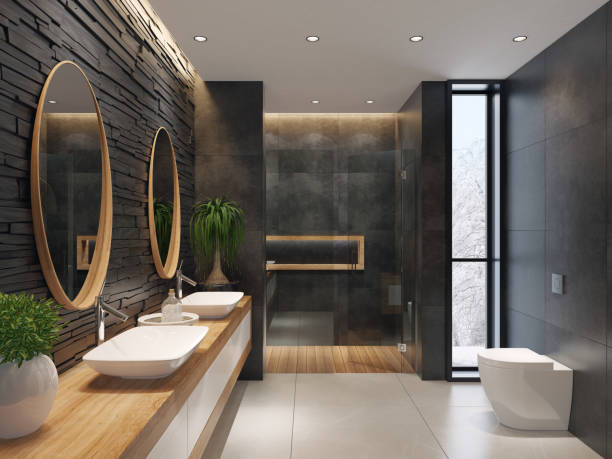
Stainless Steel Basins vs. Ceramic Basins: Which is Best For Your Bathroom?
When making a house a home, choosing the perfect basins for your washrooms is a very important step. Hand basins enhance the overall look and ambiance of a space, while also serving their essential functional purpose. The material from which your wash basins are crafted often plays a big part in determining their durability, aesthetic quality, and overall optimality. Invariably, the choice is usually boiled down to the two main contenders: ceramic basins, and stainless steel basins. So which basin is the best for your bathroom?
Ceramic Basins
As the name suggests, a ceramic basin is a type of sink made from ceramic materials and designed for washroom usage. Ceramics are a type of pottery created by shaping mixtures of clay, powders, and water into a desired form and then firing it in a high-temperature oven or kiln. This process hardens the clay, resulting in a durable, non-porous material suitable for various applications. Ceramics are commonly used for a variety of products, including dishes, vases, tiles, and of course, bathroom fixtures such as basins. In recent times, ceramic basins have gained popularity due to their numerous advantages.
Stainless Steel Basins
Stainless steel basins have become very ubiquitous over the years, and for a very good reason. Stainless steel sinks are handcrafted from heavy-gauge stainless steel, making them extremely durable. This durability - combined with stainless steel’s hygienic properties and aesthetic chic - has made stainless steel a justifiably popular choice for bathroom basin material. Stainless steel also contains a small amount of chromium, which enhances its resistance to rust and staining compared to other types of steel.
Ceramic & Stainless Steel Hand Basins: Pros & Cons
Ceramic Basins: Pros
Durability: Ceramic wash basins are renowned for their durability and resilience, making them ideal for high-traffic areas such as bathrooms. They can withstand daily use, resisting chips and cracks.
Easy to Clean & Maintain: Ceramic surfaces are smooth and non-porous, which makes them easy to clean and maintain. Stains and dirt can be effortlessly wiped away with mild cleaners, keeping the basin looking fresh and hygienic. With a non-abrasive cleaner and a soft sponge or cloth, you can easily wipe away dirt and grime, keeping the basin spotless with minimal effort.
Water Resistant: Ceramic is inherently resistant to both water and moisture, making it an excellent material for wash basins. It prevents water absorption, reducing the risk of damage such as cracking or warping over time.
Design Versatility: Ceramic basins come in many different shapes, sizes, colours, and patterns. This versatility allows you to select a ceramic wash basin that perfectly matches your style and enhances your bathroom décor. Additionally, ceramic can be glazed or painted to add colour and texture, making it a popular choice for those who wish to add their own unique artistic flourishes to their washroom aesthetic.
Heat Resistant: Ceramics have a high resistance to heat, allowing them to endure hot water without damage. This makes them ideal for use with hot water taps or in areas frequently exposed to high temperatures, and you can use hot water or heat-based products without worrying about long-term damage.
Hygienic: Ceramic is a highly hygienic material choice for wash basins, as ceramic does not propagate the growth of bacteria or mould. Its non-porous surface does not absorb bacteria or germs, which makes cleaning as simple as wiping away dirt and dust with a soft, dry cloth. This ensures your sink remains clean and safe for daily use.
Longevity: With proper care, ceramic wash basins can last for many years while maintaining their quality and appearance. They are fairly resistant to wear and tear, offering a long lifespan and providing great value for money.
Environmental: Made from natural clay and minerals, ceramics are recyclable and renewable resources, making them a terrific eco-choice for the environmentally conscious.
Affordability: Ceramic wash basins are more budget-friendly compared to materials like stone or glass, which means that there are many cost-effective ceramic basin options for you and your bathroom.
Ceramic Basins: Cons
Corrosive Chemicals: Harsh chemicals may damage the surface, so you will need to be aware of this when cleaning.
Impacts: While ceramic is a very durable material, heavy impacts or intense pressure can still cause it to shatter or crack, so you’re going to have to be careful.
Stainless Steel Basins: Pros
Durability: Stainless steel is actually known for its remarkable durability. Stainless steel's unique resistance to corrosion, oxidation, extreme temperatures, and weight-bearing capacity make it a lasting choice even under demanding conditions. Opting for stainless steel can lead to long-term savings due to its durability, reducing the need for frequent replacements.
Easy to Clean & Maintain: Stainless steel basins are extremely easy to maintain. Their non-porous nature prevents stains and odours from permeating the surface, facilitating quick and effortless cleaning.
Water Resistant: Owing to its non-porous nature, and the chromium content in its alloy composition, stainless steel is extremely resistant to water, which reduces the risk of corrosion or warping over time.
Design Versatility: Stainless steel can enhance the style and functionality of any washroom space, with a sleek and shiny aesthetic that’s as timeless as it is modern.
Heat Resistant: Stainless steel is highly heat resistant, capable of withstanding high temperatures without damage. This quality makes it suitable for use with hot water taps or in areas where high temperatures are common.
Hygienic: Stainless steel is inherently hygienic, as its non-porous surface inhibits the growth of bacteria and mould. Its smooth surface is easy to clean, promoting a cleaner and healthier environment in your kitchen or bathroom.
Longevity: Stainless steel basins have a long lifespan due to their durability, ensuring they last for many years. With proper care, you can expect your stainless steel sink to maintain its quality and appearance, providing excellent value for your investment.
Environmental: Stainless steel is 100% recyclable, with the average stainless steel object composed of about 60% recycled material, making it a prized choice when it comes to decking your home with sustainable materials. And thanks to its durability, stainless steel basins have a long lifespan, ensuring you won't need to replace your sink for many years to come. This not only saves you money but also contributes to environmental conservation by reducing waste production.
Affordability: Stainless steel basins are more budget-friendly compared to other materials, offering a cost-effective option for your home. This affordability allows you to enjoy the benefits of a durable and visually appealing stainless steel basin without overspending.
Stainless Steel Basins: Cons
Grade Variants: There are various grades of stainless steel, and some are more prone to denting easily. Higher grades like 316 (which includes molybdenum for increased toughness) offer better resistance to denting and are generally more robust.
Scratches: While stainless steel is largely impervious to the most damages, it is still easily scratched or scuffed if not properly cared for, which will not affect its structural integrity, but may still be cumbersome to those who take pride in the aesthetics of their kitchen. In order to take care of your stainless steel sink, you can clean it daily with mild soap and warm water, and dry the entire surface with a clean, soft cloth after each use. You can also prevent the buildup of mineral deposits by keeping the sink free of standing water. Avoid leaving steel cookware or utensils on the sink surface for extended periods, as iron particles can cause rust spots. Do not use cleaners containing acids, harsh chemicals, or abrasives.
Ceramic vs. Stainless Steel Basins: Which is Right for You?
| Feature | Ceramic | Stainless Steel |
|---|---|---|
| Durability | Notably durable, but prone to shattering on high impact | Extremely durable, impervious to high impact |
| Maintenance | Easy to clean/maintain | Easy to clean/maintain |
| Water Resistance | Resistant to water/moisture | Resistant to water/moisture |
| Design | Material can be glazed and painted | Material may be considered stylish but cannot be altered |
| Heat Resistance | Heat resistant, suitable for hot water taps | Highly heat resistant, suitable for high temperatures |
| Hygiene | Hygienic, inhibits bacterial growth | Hygienic, non-porous surface |
| Longevity | Offers a long lifespan if properly maintained | Offers a long lifespan if properly maintained |
| Environmentalism | Eco-friendly, made from natural and renewable materials. | Eco-friendly, 100% sustainable and recyclable material. |
| Cost | Affordable, more budget-friendly than other materials | Affordable, more budget-friendly than other materials |
The Different Types of Designs for Basins
Basins come in many shapes and sizes, including:
The Stainless Express Stainless Steel Multi Knee-Operated Basin is perfect for handwashing by multiple users in high traffic areas and/or limited spaces. Activated by pressing against the front push panels, it eliminates the necessity for electronic or mains-powered tapware, and as such, it is commonly used in commercial spaces that involve food handling, processing, manufacturing, and more. Pre-plumbed and easy to install, this basin is exceptionally durable and includes wall brackets, spouts, a pressure-limiting valve, and 40mm waste outlets.
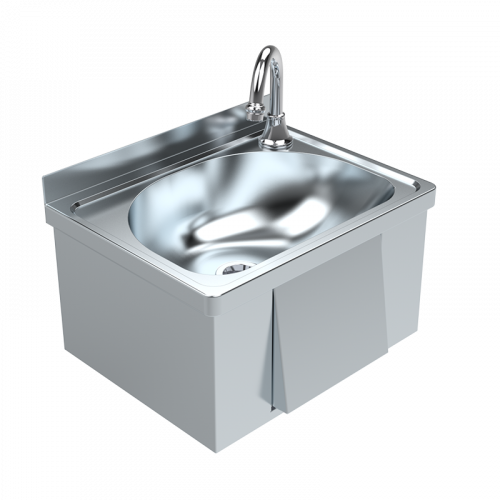
The Stainless Express Stainless Steel Wall-Mounted Hand Basin offers a sturdy and cost-effective solution for various settings, including light commercial projects, public amenities, and sporting clubs. Its front corners are chamfered at a 45-degree angle for enhanced safety. Mounted on a heavy-duty wall bracket and equipped with a 40mm waste outlet, the pressed basin area features two soap recesses and a tap landing with a 32mm tap hole. Basins can be provided with anti-vandal timed flow tapware, sensor taps, or flick mixers for added convenience.
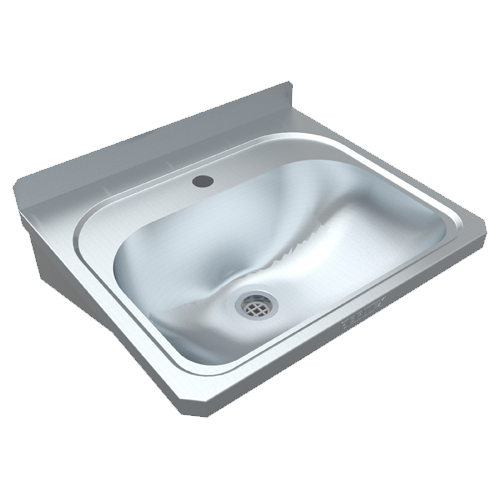
The Stainless Express 495 Ceramic Under Counter Vanity Basin combines function with a strong aesthetic appeal. With its classic rectangular ceramic form and gently rounded corners, it is smooth to the touch, making it suitable for both domestic and hospitality washrooms.
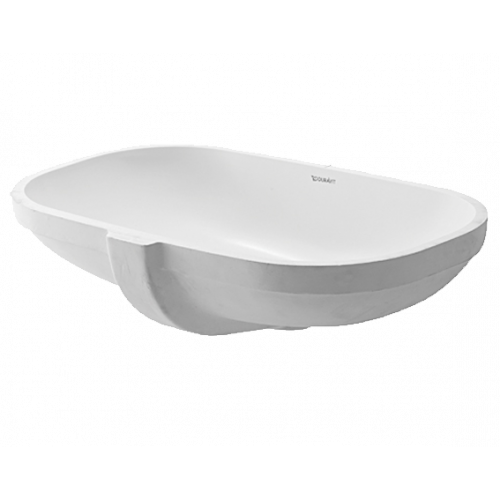
Designed for corner placement, this exquisite corner style basin maximises space in any compact area. Its contemporary design adds a touch of sophistication, blending seamlessly with any decor. This stylish corner basin not only enhances the aesthetic appeal but also prioritises hygiene and effortless maintenance, making it an excellent choice for both personal and commercial use. Crafted from high-quality, rust-resistant stainless steel, it ensures durability as well as cleanliness, and it comes with a heavy-duty wall bracket and a 40mm waste outlet for easy installation.
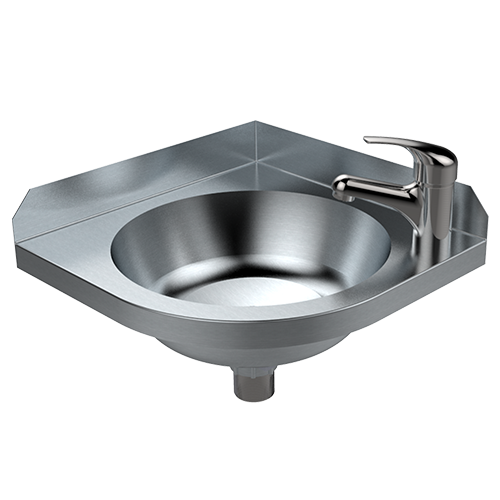
The Stainless Express 500 Ceramic Vanity Basin stands out as one of our most compact and space-saving hand basin choices. It includes practical wide tap platforms for convenient flat storage, a European-style basin overflow, and the option for left/right-hand side tap holes or no tap hole for wall-mounted tapware configurations. Versatile and chic, it pairs perfectly with the Britex 540 Compact Wall Mounted Ceramic Toilet, offering a complete compact bathroom solution.
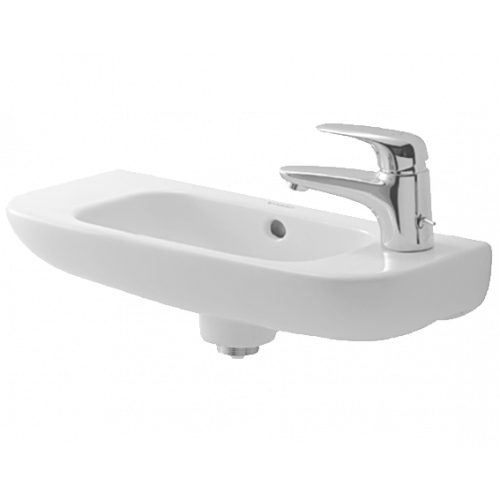
Why Do Washbasins Need Maintenance?
Regular upkeep of ceramic wash basins is crucial for prolonging their functionality and preserving their appearance. Some of the chief reasons why you should keep up basin maintenance are:
-
To Prevent Stains & Discoloration: Over time, ceramic wash basins may develop stains or discoloration from soap scum, hard water deposits, or other residues. Their glossy or glazed finish contributes to their visual appeal, making stain prevention essential.
-
To Avoid Build Up and Clogging: Routine cleaning prevents the accumulation of debris, hair, or soap residue in the drain or overflow openings of the wash basin. This ensures proper drainage, preventing potential clogs that could lead to water accumulation or slow draining.
-
To Save on Long Term Costs: You can avoid costly repairs and replacements with regular maintenance of your ceramic wash basin. Proper care and maintenance can help prevent issues that may arise from neglect or damage, saving you money in the long run.
Things to Consider Before Buying a Basin
Before committing to a new basin, you should always consider the following factors:
-
What Type of Room Is It For? Basins come in a range of sizes. Some are specifically built for large bathrooms, some are tailored to small washrooms; so knowing the dimensions of the room you need it for is someone integral before you buy. For smaller spaces like a secondary bathroom consider space-saving options like wall-hung basins, pedestal basins, or semi-recessed basins. In larger main bathrooms, you may wish to opt for a more prominent style, like an undercounter basin, an above counter basin, or a semi-inset basin. You can also mix and match designs by selecting finishes and styles that enhance your bathroom's aesthetic.
-
What Size? Always consider the basin’s intended use, as this may inform what size you need. While a small basin suffices for handwashing, especially in secondary bathrooms, larger basins offer versatility for additional tasks like applying makeup, dyeing hair, and facial cleansing.
-
What’s the Waste Situation? The basin waste connects your basin and the plumbing beneath, enabling water drainage. There are two primary types of wastes: slotted and unslotted. A slotted waste is essential for basins with overflows. When water reaches the overflow point, the slot in the waste ensures proper drainage. For basins lacking an overflow, an unslotted waste is required.
-
How Many Tap Holes? Many basins offer 0 to 3 tap holes, circular openings for tapware attachment. Some basins are hole-free, allowing customization before delivery. 0 tap holes suit wall basin sets, with taps mounted on the wall above. 1 tap hole accommodates mono basin mixer taps, featuring a single lever for hot and cold water. 2 tap holes are ideal for traditional pillar taps, offering separate hot and cold controls. 3 tap holes support dual-handle setups, along with a spout, available in various designs and finishes.
Conclusion
At Stainless Express, we are globally renowned for our innovative stainless steel products, commercial-grade plumbing fixtures, and architectural fittings. You can browse our ceramic basins here, and browse our stainless steel basins here. To see our wide range of stainless steel & ceramic products, head over to the Stainless Express homepage, where you will be able to find urinals & toilets, benches & shelves, and so much more. Got a question? Don’t hesitate to get in touch with Stainless Express via our contact us page.
 +(03) 9466 9000
+(03) 9466 9000
